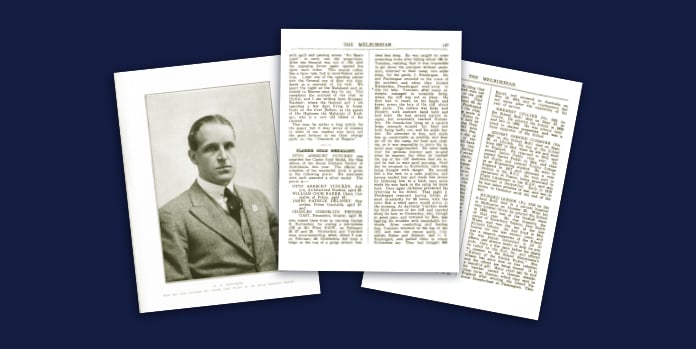The following is an excerpt from The Melburnian 1924 vol 49, p 187. It describes the harrowing rescue of George Nichterlein by Otto Yuncken (OM 1921) for which Otto received the Clarke Gold Medal.
You can find out more about Otto Yuncken’s story here.
Otto Abrecht Yuncken was awarded the Clarke Gold Medal, the blue ribbon of the Royal Humane Society of Australasia, this year. The official description of his wonderful work is given in the following precis. His associates were each awarded a silver medal. The precis is:
Otto Abrecht Yuncken, Auburn, Architectural Student, aged 20; William Cook Baker, Omeo, Constable of Police, aged 43; James Patrick Delaney, Benambra, Police Constable, aged 37; and Charles Cornelius Pendergast, Benambra, Grazier, aged 35 risked their lives in rescuing George E. Nichterlein by scaling a precipitous cliff at Mt Pilot NSW on February 26, 27 and 28.
Nichterlein and Yuncken were mountaineering, when, about 9 am on February 26, Nichterlein fell from a ledge at the top of a gorge several hundred feet deep. He was caught on some projecting rocks after falling about 100 feet.
Yuncken, realizing that it was impossible to get down the precipice without assistance, returned to their camp, two miles away, for their guide, [“Big Jack”] J. Pendergast.
He and J. Pendergast returned to the scene of the accident, and, when they located Nichterlein, Prendergast went away to ride for help.
Yuncken, after many attempts, managed to scramble down where the cliff was not so steep. He then had to crawl, on his hands and knees, across the face of the cliff – about 200 yards. The surface was loose and slippery, with insecure hand hold and foot hold. He had several narrow escapes, but eventually reached Nichterlein. He found him lying on a narrow ledge, seriously injured, his head and body being badly cut, and his ankle broken.
He attended to him, and made him as comfortable as possible, and then set off for the camp, for food and clothing, as it was impossible to move the injured man single-handed. He went back over his perilous journey and secured what he wanted but when he reached the top of the cliff darkness had set in, and he had to wait until morning.
Next day he returned to Nichterlein, each step being fraught with danger. He moved him a few feet, to a safer position, and having tended him and made him secure by fastening him toa bush, once more made his way back to the camp for more food. Once again darkness prevented his returning to his friend.
That night J. Pendergast returned, having ridden almost incessantly for 28 hours, with the news that a relief party would arrive in the morning.
At daybreak Yuncken made his third descent of the cliff, and crawled along its face, to Nichterlein, who, though in great pain, and tortured by flies, was bearing his troubles with remarkable fortitude.
After comforting and feeding him, Yuncken returned to the top of the cliff, and met the rescue party, Constables Baker and Delaney, and C. C. Pendergast, and guided them to where Nichterlein lay.
They had brought 200 feet of rope with them, and deciding that the only way to get the injured man out was up and across the face of the cliff, they began the perilous ascent. They had to scale an incline of about 60 degrees for a thousand feet. Pendergast and Delaney climbed up with the rope, over shifting shale, and, having made it fast, lowered it. Yuncken and Baker remained with Nichterlein. Baker held on to the rope, with Yuncken lifting Nichterlein in a blanket, and so they were drawn, a foot at a time, to where Pendergast and Delaney were.
One slip or false step, or the giving way of the loose foot hold, or hand hold, would have meant certain death. Five times this operation was repeated, until, having gone 1,000 feet in between six and seven hours, they met another rescue party, [namely] John Freebody, Sgt Cameron of Jindabyne NSW, and J. Pendergast.
The worst was over then, but it took the work of them all to complete the rescue. They placed Nichterlein on a blanket, of which Baker, Freebody, Cameron and Yuncken each held a corner, while the others pulled them along. In this way. going about 20 yards at a time, they reached the top of the mountain, after ten hours’ hazardous and exhausting work.
Each step of the first 1000 feet was a danger, not only on account of the insecure foothold and the steep ascent, but because of the risk of being struck by falling rocks. The cliff was almost sheer 100 feet above and hundreds of feet to the valley below.
Note 1: After Nichterlein was rescued, it took nearly three days of traveling with him on a horse before the party reached a track accessible by horse and buggy. He was then transported to a nearby homestead to rest before continuing to Omeo for medical treatment. The latter part of the journey, about 30 miles, was completed by car over some of the roughest terrain in Victoria “over which many city motor-drivers would refuse to drive.”
Source: The Argus, 3 March 1924
Note 2: Some modest (mainly grammatical) changes to the original Melburnian article have been made to aid clarity.



